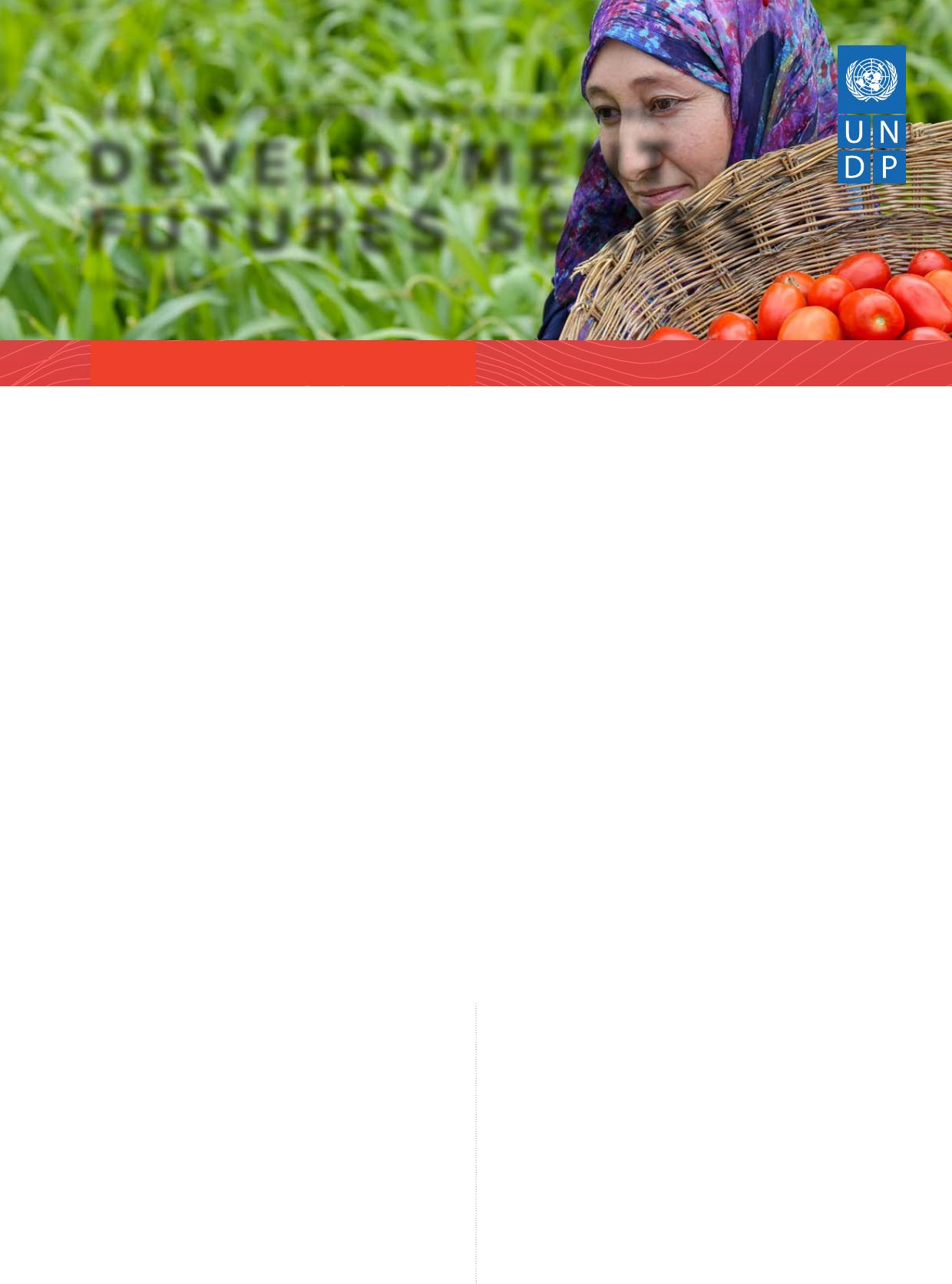1UNITEDNATIONSDEVELOPMENTPROGRAMMEJune2023WomenasAgentsofChangeforGreeningAgricultureandReducingGenderInequalitybyMeeranJamal1Thepolicybriefhighlightstheessentialityofwomeninagricultureandtheirpotentialroleinshiftingtosustainableagriculture,increasingfoodsecurityandincreasingagriculturalproductivitywhentheyhaveaccessandabilitytoadoptinnovativeagriculturetechniquessuchasclimate-smartagriculturepractices(CSA).Thispolicybriefidentifieskeyactionsthatcanremovebarriersforwomeninagriculture,includingcollectionofgenderdisaggregateddataforgender-sensitiveplanning,researchanalysis,advocacyforequitableaccesstoproductiveassets,capacitybuildingandawarenessraising,andcross-sectorcollaborationstoenablegender-equitableaccesstoinfrastructure,financialcapital,productiveassetsandotherservices.IntroductionDespiteanationalcommitmenttoreducinggenderinequality,Pakistanisslidingdownonglobalgender-equalityindices.Thecountry’sgendergapwidenedby0.7percentin2021,and,at145outof146countries,itholdsanabysmallylowrankontheGlobalGenderGapIndex2022.2Gender-relatedindicatorshaveshownsluggishgrowth,butthegendergapstillprevails.Althoughwomen’sempowermentisdeemedintegraltothecountry’soverallsocialandeconomicdevelopment,inPakistan,womenarelargelyleftbehindinthedevelopmentprocess.AccordingtoPakistan’svoluntarynationalreviewoftheSustainableDevelopmentGoalsin2019,addressingwomen’seconomicempowermentandthegenderdisparityoverallinPakistancanaddUS$91.5billiontothecountry’seconomy.Oneareawherewomencanplayasubstantialroleintermsofsocio-economicbenefitsistheagriculturesector.TheagriculturesectorinPakistancontributes19.2percenttothenationalGDP,employsapproximately37.4percentofthepopulation3andprovideslivelihoodsto62percentofthepopulation.4ArecentlypublishedreportbytheNationalCommissionontheStatusofWomenandUNDPPakistanentitled‘ClimateEquity:WomenasAgentsofChange2022’5demonstrateshowclimateUNDPGlobalPolicyNetworkBrief©UNDPPakistanDEVELOPMENTFUTURESSERIESDEVELOPMENTFUTURESSERIESUNDPGlobalPolicyNetworkBrief2changeimpactsareminimizedwhenburdenstogenderequalityarereducedandwomencanexerttheirpowerasagentsofchange.Giventhatwomenarecentraltoagriculture,thepolicybriefemphasizesthatwomencanplayasubstantialroleingreeningagriculture,reducingclimatechangeimpact,decreasingfoodinsecurityandincreasingagriculturalproductivitywhengenderbarriershavebeenremovedandtheyhaveaccesstoclimate-smartagriculturepractices(CSA).Givenwomen’sindigenousagriculturalknowledge,usingtheNationalCommissionontheStatusofWomen’sreportasabase,thispolicybriefexploreskeychallengeswomenfaceinactingaspositiveagentsofchangeforgreeningagricultureinPakistan.Throughsecondaryresearchfindings,itsuggeststhatequippingwomenwithskills,capacity,knowledgeandopportunitiestoaccessandutilizeCSAwillenhanceagriculturalproductivityandincreasefoodsecurity.Tobeginwith,itisimportanttocomprehendthecentralityofwomentoagricultureinPakistanandwhytheycanbeinstrumentalinimplementingCSApracticesinthecountry.Thefirsttwosectionsdiscussthisconcisely.Thesubsequentsectioninvolvesconductingsecondaryresearchtofindprecedenceinliteraturetosupportthisidea.Thefinalsectionofthepolicypaperprovidesrecommendationsthatcanpotentiallymitigategenderbarriersandsimultaneouslyenhanceclimate-resilientagricultureproductivity.Women’scentralitytoagriculturalproductivityWomenfarmersindeedhavethepotentialtobecentraltotheagricultureeconomyastheyalreadyplayasubstantialroleinensuringfoodproductionandsecurity.Accordingto2011researchbytheUnitedNations’FoodandAgricultureOrganization,indevelopingcountries,women-managedfarmshad20to30percentlessagriculturalproductivitythanfarmsmanagedbymen.Itwasestimatedthatclosingthisgapwouldnotonlyboostproductionby2.5to4percentbutalsoimprovefoodsecurityandenhancethewelfareofruralhouseholds.6InPakistan,outof15.34milliontotalemployedwomen,12.9millionliveinruralareasand10.4millionareemployedintheagriculturesectoralone,accountingforabout68percentofthetotalwomenemployed7—letalonethatalmosthalfoftheagriculturalworkforceofPakistancomprisesoffemaleworkers.Theyspend,ifnotmorethanmen,atleastacomparableamountoftheirtimesupportingagricultureactivities,inadditiontotheirunpaidcareworkanddomesticworkresponsibilities.Forinstance,onaverage,awomanasanagricultureworkerspends32.5hoursweeklyascomparedto47.1hoursspentbyaman.8Womenareinvolvedindifferentcropfarmingactivitiesand,asaresult,accumulateindigenousknowledgeregardingagriculturepractices,suchashoeing,threshing,sowing,seedstorage,weeding,tendingtolivestockandmilking,processingmilk,treatingsicklivestock,feeding,collectingfodder,processingwoolandhair,breeding,poultrycare,cleaningshelters,weaning,cottonpickingandconvertingmanuretofuel.Inaddition,womenplayasubstantialroleintheproductionofcotton,oneofthehighest-earningsourcesofforeignexchangeinPakistan,becausemostcottonpickersarewomen.Anticipatingthepotentialadvantagesofinvolvingwomeninclimate-smartagriculture(CSA),thispolicypaperproposesthedevelopmentoftheirskills,capacity,knowledgeandaccesstoCSApractices.Thequestionsarise:DoCSApracticesenhanceclimate-resilientandsustainableagricultureproductivity?Whyshouldwomenspecificallybetargetedforthiseffort?Thesubsequentsectionsprovideanexplanationforthisapproach.WomenasagentsofchangeforgreeningagricultureGiventheneedforgreeningagricultureinPakistanandthecentralityofwomeninagriculture,thispolicybriefintendstoexplore,throughadeskreviewoftheinternationalandnationalliterature,thepropositionthatreducinggenderbarriersinaccessingandutilizingCSApracticescanenablewomentoserveasagentsofchangefortransitioningtogreenagriculturalpractices,increasingproductivityandreducinggenderinequality.Thehypothesesbeingexploredarelistedbelow.1.CSApracticesenhanceclimate-resilientandsustainableagricultureproductivity.DEVELOPMENTFUTURESSERIESUNDPGlobalPolicyNetworkBrief32.WomenfacebarriersinaccessingandutilizingCSApractices.3.Enhancingwomen’sskills,knowledgeandabilitiesbyremovinggenderbarriersleadstobetteragriculturalproductivity,increasedempowermentofwomenandgreatereconomicvalue,ultimatelyleadingtoareductioningenderinequality.CSApracticescanenhanceagricultureproductivityandclimate-resilienceTheagriculturesectorinPakistancomeswithitsownsetofdifficulties.Intermsoffoodsecurity,about48percentofhouseholdsaremoderatelyfoodsecure,andonethirdareseverelyfoodinsecure.9Thecountryranked75outof113nationsintheGlobalFoodSecurityIndex2021and92outof116nationsintheGlobalHungerIndex2021.Itrecordeda12percentdecreaseinthescorefrom2000onwards;thereby,thecountryiscategorizedataseriouslevelofhunger,reflectingtheneedtoenhanceagriculturalproductivity.10However,theviabilityofagricultureisseverelyinfluencedbyclimatechange.Forinstance,studiessuggestthatsomecropsinPakistancanbehighlysensitivetochangesintemperatureandwatersupply;11forinstance,atemperatureriseintheregionrangingfrom0.5°Cto2°Ccanresultinan8percentto10percentlossinyieldfordifferentcrops.12Sugarcaneandrice,amongtheprimarycropsofPakistan,aretheworstaffectedunderahighemissionsscenario;theyexperiencearound20percentand25percentyieldreductions,respectively.13Aweakenedagriculturesectorcontributestothehighervulnerabilityofpeopledependentonagriculturefortheirfoodandlivelihoods.14ThisrelationshipandthefactthatPakistanisamongthecountriesmostvulnerabletoclimatestressindicatesthatakeenerfocusonthegreeningofagricultureinPakistanisrequired.Thispolicybrieffocusesononemechanismforgreeningagriculture,theutilizationofclimate-smartagriculture(CSA)practices.CSAisanintegratedapproachusedfortransformingagri-foodsystemstowardsgreenandclimate-resilientpractices.Thisapproachalsoincludesenhancingprofitabilityinthesectorforgreatereconomicgains,reducingnegativeexternalities(e.g.,carbonemissions)andboostingpositiveones(e.g.,carbonsinkorbiodiversity)andefficientutilizationofresourcestorebuildnaturalcapitalassets.15ThereisampleevidenceinthenationalandinternationalliteraturetosupporttheclaimthatCSAcanenhanceagricultureproductivityandclimateresilience.Forinstance,aprojectinChinathatinvestedinCSApractices,suchasefficientuseofwater,on44,000hectaresoffarmarea,improvingirrigationinfrastructureandwaterdeliveryactivities,wasabletoimprovesoilconditionsandboosttheproductionofriceandmaizeby12percentand9percent,respectively.Thestudyreportedhigherincomesandincreasedclimateresilienceformorethan29,000farmers’cooperatives.16AnotherstudyrevealedthatbyutilizingCSAtechnology,greenhousegasemissionswerereducedbybetween7and23percentofglobalwarmingpotentialand42to129percentofeconomicbenefitswereachieved.17ThenationalliteraturealsoshowsprecedenceforCSApracticesresultinginhigheragriculturalproductivityandenhancingclimateresilienceinPakistan.Forexample,astudyoncottonproductionintheLowerBariDoabCanalirrigationsystemofPunjabinvestigatedthefinancialreturnsandimpactofCSApractices(utilizingsustainablewaterusemanagement).TheresultsrevealedthatadoptersofCSAhad13percenthigheryieldsthanunderconventionalagriculturepractices,saved58percentmorewaterandwereenvironmentallyfriendlyandclimateresilient.18Anempiricalstudy,‘Heterogeneouseffectsoftheadoptionofclimate-smartagricultureonhouseholdwelfareinPakistan’,revealedthattheimplementationofCSApracticesconsiderablyreducedhouseholdfoodinsecurity,enhancedhouseholddiversityandreducedheadcountandseverityofpoverty.19AnotherempiricalstudytestingtheadaptationimplicationsofCSAinruralPakistanproducedsimilarresults.AdaptationofCSApractices,suchaschanginginputmix,diversifyingseedvarietyandtakingsoilandwaterconservationmeasures,resultedinpositiveandsignificantimprovementinnetfarmreturnsandreducedfarmers’exposuretodownsiderisksandcropfailure.20Furthermore,researchconductedinPunjabconfirmedthatfarmerswhofullyadoptedCSApracticesforcotton,wheatandricecropsgained32percentand44percentkg/hahigheryieldand45percentand48percenthigherUSdollarsperhathanfarmerswhodidn’t.21Whiletheliteraturesupportsthehypothesis,italsopavesthewayforfuturein-depthresearchtoexplorethebestCSApracticesinthecontextofthecountryanditsagroclimaticconditions.DEVELOPMENTFUTURESSERIESUNDPGlobalPolicyNetworkBrief4Theliteraturereview,thus,doesrevealprecedentforCSApracticesenhancingclimate-resilientandsustainableandprofitableagricultureproductivity.GenderbarriersinaccessingandadaptinginnovativeagriculturepracticesAninternationalqualitativeandquantitativestudywasconductedinthreeareasofEthiopiatoexaminetheeffectsofgenderedconstraintsonadoptingclimate-smartagricultureamongstwomen.Thefindingsrevealedthatwomen,beingsmalllandowners,couldn’tuptakeCSApracticesduetolimitedaccesstocreditandextensions,lackofaccessoruserrightstoland,restrictedaffiliationwithcooperativesandwaterassociations,lackofskills,training,andinformation,andrestrictedmobility.22Pakistanisnodifferentinthismatter.Manyclimate-smartagriculturepracticesalreadyexistinvariouspartsofPakistantotacklevariousenvironmentalchallengeswhilesimultaneouslyenhancingagriculturalproductivity.SomeoftheseareusedinPunjab,SindhandKhyberPakhtunkhwaregion.AlthoughadoptingCSApracticesislikelytohaveasimilarimpactonenhancedagricultureproductivity,regardlessofthegenderofthefarmer,successintheuptakeofthesetechnologiesisoftencounteredbygenderedconstraints.23However,despitetheirvalueaddition,womenfarmersinPakistanremainatadisadvantageascomparedtomalefarmersintheadoptionofinnovativeagriculturepractices.Forinstance,Pakistanoffersagricultureextensionservices(AES),anessentialmechanismthathelpsfarmersenhancetheirknowledgeandcapabilitiesbytrainingthemonhowtoadoptanddisseminateagriculturalinnovationssuchasCSApractices.Thisisnormallyachievedthroughfielddemonstrations,face-to-faceadvisoryservicesandtheuseofelectronic,printandothermediaforms.However,womenfarmersfacechallengesinaccessingtheseofferings,whichdeprives,restrainsorrestrictsthemfromaccessingorutilizingtheCSAapproachesand,inturn,limitsthepotentialuptakeandimpactofCSAforpositivefoodproductivityandclimateactioninthecountry.Furthermore,astudywasconductedin2022onwomenfarmersworkinginPunjabtoassesstheirdecisionalempowerment,theirinnovativenessandtheirroleinadoptingCSApracticesatthefarmlevel.Datagatheredfrom384farmshavinghigherinvolvementofwomenrevealedthatmostwomenfarmerslackeddecisionalpowerrelatedtoproductiveassetssuchasattainingcredit,selling,rentingandpurchasingfarmlandandutilizingfarmmachinery.24Othersimilarconstraintsarediscussedbelow:Lackofadequatefocusinpolicydocumentsongender-responsiveandgender-ledmeasuresinPakistanThereislittlenationalorprovincialgenderpolicyspecifictotheagricultureandruraldevelopmentsector.TheprovincialgovernmentsarepredominantlyresponsiblefortheprovisionofAES.WhilethereisapolicyintentandsomeeffortshavebeenmadetoimproveaccesstoAESforwomenfarmerssuchasinPunjab,thereisnodataavailabletoverifythenumberofwomenfarmerswhoareaccessingextensionadvice.25Inaddition,PunjabandSindh’sagricultureandfoodsecurityandgenderpoliciesmentionextendingAES,particularlytowomen,butitisunclearhowthesepolicystatementsarebeingtranslatedintoimplementationplansintheagriculturesector.26Gender-blindagricultureextensionservicesInPakistan,theseservicesarepredominantlyavailabletomalefarmers.Accordingtoaresearchprojectonruralfarmersinthecountry,femalefarmersfaceddifficultiesinaccessingAES.Accordingtopopularopinion,AESwaslargelygender-insensitivebecausetheexistingAESserviceprovidersconsideredwomentobefarmhelpersratherthanfarmersintheirownright.Gender-insensitiveextensionservicesreflectthisopinion,implyingthatauthoritiesneitherdesigngender-inclusiveAESservicesnorhavegender-sensitivestafftodelivertheextensionservices.2Mostprovinceshaveadearthofwomenextensionstaff.Currently,inPunjab,25percentofofficersarewomen;inSindh,9percentofagricultureofficersand5percentoffieldassistantsare.Rawalpindi,asemi-urbancity,hasthehighestrepresentationofwomenagricultureofficers,at60percent.27Despitetheseslightlyimprovednumbers,therearemilestogobeforegenderparityinAESandgender-sensitiveAESplanningcanbeexpected.Additionally,thereisanabsenceofaccountabilityandcoordinationmechanismswithintheagriculturesectorinPakistantoensuregendermainstreaming.Whiletherearewomen’sdevelopmentdepartmentsattheprovinciallevel,theylacktheresourcesandcapacitiestosupporttheagricultureextensiondepartments(AEDs)inmainstreaminggenderintheplanningandimplementationofAES.28DEVELOPMENTFUTURESSERIESUNDPGlobalPolicyNetworkBrief5PoorliteracyratesofwomenfarmersExistingpoorliteracyandlanguagelimitationsamongfemalefarmerscreatehurdlesfortheminaccessingandlearningaboutinnovativeagriculturepractices.WomenhavelowerlevelsofliteracyandeducationcomparedtomeninPakistan.Mostfemalefarmersarebasedinruralareas,whereonly40.84percentofwomenareliteratecomparedto67.15percentofmen.29Thisbarrier,however,canberesolvedbyusingawiderangeofcommunicationmethodstoprovideadvisoryservicessuitabletofemalefarmers’needs.SocialandculturalbarriersSocialandculturalchallengessuchasmandatorypardah(veil)forwomencreateanobstacleinthepathofavailingAESaswell.TheexistinglimitedAESthatareextendedtowomenareconfinedtoclosedspaces,whichpreventsthemfromparticipatinginfielddemonstrationsandlearningbydoinginmostprovinces,withafewexceptions,suchasinSindh.30Additionally,itiscustomarythatwomennotattendthistraining.Thewomenthemselvesfinditnon-essential.Similarly,women’ssocialstandinginahouseholdandtheirlimiteddecision-makingpowertomanageagricultural-relatedtechniquesonfamilylandinPakistanalsorestrictwomenfromexpansionoradaptinginnovativeagriculturesuchasCSApractices.31,32LackoflandownershipandcontrolWomenfarmersinPakistanoftenfacechallengesrelatedtolandownershipandcontrol,includingsmallerlandholdings,insecurelandtenureandlimitedaccesstoland.Only1.2percentofwomenownlandinPakistan,letalonefarmland.33Thisexclusionisaconsequenceofconflictinglegal,religiousandcustomarylaws,deeplyingrainedpatriarchalattitudes,notaddressingwomen’spropertyrightsandlimitingwomen’sabilitytoclaimandcontrolland.34Despitesomelegalandpolicyinitiativestoensurewomen’srights,includinginheritance,35theirimplementationandenforcementremainsachallengeowingtoapatriarchalmindsetandmale-orientedpowerdynamicsinthecountry.Whilethestatehastakenscatteredmeasures,suchasprovidingcultivableland,toempowerwomen,theeffectivenessofthesemeasuresremainslimited.Withouthavingownershiporcontroloverland,womenfarmerscandolittletoadaptinnovativeagriculturepracticessuchasCSAtoenhancetheirproduce.36,37Inequitableaccesstoinformation,technologyandtoolsinPakistanMobilephonesareoftenutilizedbyfarmersforaccessingbankingfacilitiesandagricultureextensionservices,suchasforadvice,identifyingseeds,diseasesandpests,checkingrainfallmeasurementsandsoforth.However,duetolimitedaccesstoorownershipofmobilephones,womenfarmersoftenremaindeprivedofthisinformation.Only17percentofwomeninruralareashaveownershipofamobilephoneascomparedto61percentofmen,andonly7percentofruralwomenusetheInternetascomparedto16percentofmen.38Thesefiguresareprobablyevenloweramongfemalefarmersduetopoordigitalliteracyandknow-howofmobileandInternetusage.39,40AccordingtoresearchconductedbyFatimaFertilizerCompany,TikTokwasfoundtobethemostpopularmediumamongyoungfarmers,YouTubeamongolderfarmers,andradioandTVamongseniorfarmers.Mostofthesubscribersweremen,withwomenaccountingforonly1percentofusers.41Inaddition,womenoftenlackconnectionsoutsidetheirvillagesandhardlyeverbecomemembersofanycooperatives,whichrestrictstheiraccesstothepotentialexchangeofinformationontheusageofcorrectherbicidesandpesticides,watermanagement,technologiesandsoon.InequitableaccesstofinanceWomenfarmersoftensufferfrominequitableaccesstofinancialcapitaltomakeinvestments,hirelabour,purchasefertilizers,etc.42,43Thedisparityinaccesstocredit,fertilizers,waterandmarketlinkagespersistsinPakistanandinpartsofSub-SaharanAfrica.44Furthermore,evenifwomenfarmersaremotivatedtouseCSApractices,theymightnothavethedecision-makingpowertodoso.Agender-disaggregatedanalysisrevealsthatwhileadultwomen’sformalfinancialaccountownershipincreasedfrom4.84percentin2014to13.48percentin2021,formenitincreasedfrom20.97percentin2014to28.8percentin2021.45Thisimpliesthatalmost87percentofadultwomeninPakistanstilldonothaveaformalfinancialaccount.Withthecurrenttrendoffinancialinclusionofwomen,itmaytakealmostuntil2034forallwomenabove15yearsoldtohaveformalfinancialaccounts.46Theexistingincreaseinthefinancialaccountisattributabletomobilemoneyaccounts.Despitethat,onlyfouroutof100womensucceedinsecuringloansforagriculture.47,48,49,50DEVELOPMENTFUTURESSERIESUNDPGlobalPolicyNetworkBrief6Timeconstraintsandtheadditionalworkloadofcaregivinglimitwomen’savailabilitytolearnaboutnewagriculturalpracticesOneofthemajorissuesrestrictingwomen’stimetoparticipateinanykindofskillstrainingbyagricultureextensionservicesisunpaidcarework.MostwomeninPakistanareresponsiblefortakingcareofchildren,elderly,householdchoresandthelike.Unfortunately,extensionstaffoftenoverlookthisissueanddonotconsultwomendirectlywhenschedulingtraining.51,52Inonestudy,agricultureofficersandwomenfarmersreportedthatdespitewomen’sindigenousknowledgeofagricultureproductivity,femalefarmersweren’tabletobenefitfromanyexistingagriculture-relatedtrainingduetotimeconstraints.Additionalcaregivingdutiesanddomesticworkkeepwomenfarmersoccupiedduringthetimeagriculturaltrainingsareoffered,preventingthemfromenhancingtheiragriculture-relatedskillsandknowledge.Therearenoday-carecentresintheagricultureofficesortrainingareas.53Inequitableaccesstohigh-qualityinputmarketsandlinkagestooutputmarketsWomenfarmersinPakistanfacesignificantchallengesinaccessingmarketsduetosocialandculturalnorms,limitedknowledgeaboutmarketopportunitiesandprices,inadequateinfrastructurerestrictingmobilityandlimitedaccesstocreditandfinancialservices.AresearchstudyfoundthatwomeninadairycooperativeinPunjab,withdirectaccesstohigh-qualitymarkets,wereabletoearn25percentmorethanwomenwhosoldtheirmilktomiddlemen.54Withoutmarketknowledge,womenareoftencompelledtoselltheirproductstomiddlemenataratelowerthancompetitivemarketprices.Thistranslatesintolowerprofits,limitingwomenfarmers’abilitytoreinvestintheirfarmsforexpansionortoutilizeinnovativeagriculturepracticestoimprovetheirproduce.55Suchlimitationsinknowledgeandinaccessingagriculturaladvisoryservicespreventwomenfarmersfromlearningaboutagriculturalinnovationssuchasclimate-smartagriculturepractices.Thispolicybrief,thus,makesthecasethattoutilizethesefemalefarmworkersasagentsofchange,itisessentialtoinvestintheircapacitiesandreducegenderbarriersforatransitiontosustainableandclimate-smartagriculturepractices.Itisverymuchanopportunityinthisrespect,56assuchinvestmentislikelytonotonlyenhanceagriculturalproductivityandincreasefoodsecuritybutalsotoenhancewomen’sagencyand,inturn,furtherreducegenderinequality.Thus,itwillfilltwoneedswithonedeed.ThequestionariseswhetherthereisprecedenceintheliteraturethatreducingthesebarrierswillenablewomentoadoptCSApracticesandenhanceagricultureproductivity.Thefollowingsectiondiscussesthattopic.Reducinggenderbarriersinagricultureenhancesproductionandwomen’sagencyThethirdclaimofthispolicypaperfoundsupportprimarilyintheinternationalliterature.Forinstance,researchconductedonagriculturalproductivityinthreecountries,Malawi,UgandaandTanzania,estimatedthatbyeliminatingthegendergapinagriculturalproductivity,cropproductionmayincreaseby7.3percent,2.8percent,and2.1percent,respectively.ThismaygenerateanannualincreaseinGDPby$100millioninMalawi,$67millioninUgandaand$105millioninTanzania.Infact,eliminatingthegendergapmayliftupto238,000peopleinMalawi,119,000inUgandaand80,000inTanzaniaoutofpovertyinayear.57Similarly,astudyconductedinNigeriafoundthatclosinggenderproductivitygapsresultsingainsinthecountry’syieldsby2.8percent.58Theliteraturefindsthatenhancingwomen’sskillsandprovidingthemwithtrainingcanleadtoanincreaseinwomen’sagencyandareductioningenderinequality.Forinstance,Vietnamesewomenfarmers,afterreceivingtrainingandeducationoncropproductionandmanagement,notonlyimprovedtheirfarmproductivity,diversifiedproductsandincreasedincomesbutalsowereabletoenhancetheirroleinhouseholddecision-makingonselection,managementandprocessingofcrops.Asurveyconductedamongthesewomenfoundthat75percentfeltanimprovementintheirsocialpositioninthehouseholdandcommunity,and84percentfeltmorerespectedbytheirhusbandsandfamily.59Havingmoredecisionalpower,thus,impliesareductioningenderinequalityovertimeaswell.InPakistan,UNDP’sprojectonestablishingclimate-resilienttunnelfarmsforwomendeliveredsimilarresults.Oneofthebeneficiaries,RozinaBabar,reported,“Itmakesusfeelempoweredthatweareabletocontributeeconomicallyforourhouseholds.Italsoimprovesoursocialstatusandinteractionswithotherpeopleinthesociety.”60Whilethereisadearthofnationalliteratureavailableforsupportingtheaboveclaim,especiallywithregardstoenhancingwomen’sagency,inferencefromtheinternationalliteraturecanfillthegaptosomeextent.However,italsoestablishestheneedtoconductsimilarresearchinPakistan’scontextDEVELOPMENTFUTURESSERIESUNDPGlobalPolicyNetworkBrief7toexploredifferentwaysinwhichthereductionofgenderbarriersinagriculturecanincreasetheagencyofwomenalongwithagriculturalproductivity.Overall,theliteraturedoessuggestthataddressinggenderbarrierswillreducegender-equalitygapsand,thus,enablewomentoadoptCSApracticesandplayapositiveroleinadvancingthosepracticesforatransitiontogreenandsustainableagricultureandincreasedfoodsecurity.Whatcanbedonetoreducethesegenderbarriersforwomenfarmers?Thenextsectiondiscussesthisandthewayforwardinlightoftheliteraturereview.Reducingthegendergapforgreeningagriculture:ThewayforwardAroundtheworld,significanteffortsareunderwaytodevelop,pilotandscaleupCSApracticesandtechnologiestomakeclimatechangeadaptationeasierforwomenfarmers.Pakistanneedstofollowthetrend,giventhepotentialofwomenfarmersinthecountry.Reducinggenderbarrierswillenablemorewomentoplayapositiveroleingreeningagriculture,increasingagricultureproductivity,enhancingwomen’sagencyand,inreturn,furtherreducinggenderinequality.Aspertheresearch,thiscanbeachievedthrough:Genderanalysisandcollectionofgender-disaggregateddata:Collectinggender-disaggregateddataandconductinggenderanalysiscanuncoverrealities,suchaswhoholdsdecision-makingpower,howmuchintrahouseholdbargainingtheremightbeinidentifyingspecificvulnerabilitiesandwhatisresourceallocationlikewithinthecommunity.Thiswillhelpinestablishingabaselineofgender-disaggregateddataaswell.61Thisanalysiswillobviouslybetime-consumingandcostly;however,itwillhelpinavoidingpromotingCSApracticesthatmaybesafeenvironmentallybutaremaladaptiveorregressivesocio-economically.62Itwillhelpinredesigninggender-sensitiveagricultureextensionprogrammingthataddressesspecificneedsandbarriersfacedbywomenfarmers.Forinstance,accordingtotheCSAprofileofKhyberPakhtunkhwa,itisessentialtomakegenderanalysisofCSApracticesamandatoryactionacrossdifferentfarmingandculturalsystemstounderstandthelevelofgenderinequalityandfacilitatetheadoptionofCSApracticesbywomenfarmers.63Strengtheninggovernmentcapacitiesforinclusiveagricultureextensionservices:Thereisaneedtoestablishinstitutionalchangetodevelopcapacityandbuildcommitmenttogenderequalityandwomen’sempowermentacrossagriculture-relatedgovernmentdepartments.64Asafirststep,thiscommitmentcanbebuiltbyhiringmorewomenagriculturaladvisoryofficerswhoaretrainedprofessionalsequippedwithskillstodeliverinclusiveagricultureextensionservices.Thiscanbefollowedbysettingupgenderfocaldeskswithinagricultureextensiondepartments(AEDs);establishingcoordinationmechanismsbetweenAEDsandwomendevelopmentdepartmentsforgreateraccountability;sensitizingandtrainingAEDofficialsontheimportanceofinclusionofwomeninAESthroughcapacity-buildingtraining;settingupchild-carefacilitiesinagricultureofficesfortraineesandfieldextensionstaff;translatinganddeliveringthetraininginlocallanguagestoaddressthepoorliteracybarrier;andestablishingapracticeofconsultingwomenfarmerswhenschedulingAESactivitiestoensurethatinterventionsdonotcreateaprivilegesystemandbarriersforwomen.65Gender-proofingpoliciesandeliminatinglegaldiscrimination:Itisessentialtoevaluateandreformpoliciesandlawsthatunfairlydiscriminateagainstwomen’slandrights,includingownership,controloverland,inheritancelaw,propertylawandlandtenuresystems,toensureequitableaccesstolandandotherproductiveassets.Forinstance,thereisaneedforthedevelopmentofgender-mainstreamingpolicyforprovincialAEDstomakethemmoregender-awareandgender-responsive.Thereisaneedtodevelopgenderactionplansforagriculture-basedpolicies,assuchplansarealmostnon-existentrightnow.Increasedadvocacyandoutreach:Anypolicyreformsmustbeaccompaniedbyadvocacyandoutreachelementstoensuretheimplementationofthosepolicies,enhancedaccountabilityandawarenessamongstthemainbeneficiariesandimplementors.66Similarly,advocatingtoinstitutionalizethecollectionofgender-disaggregateddataisessentialformakinginformeddecisionswhenplanningCSAactivitiesaswellasformonitoringandevaluation.Besidesthat,raisingawarenesstoeducatewomencanleadtotheirenhancedagencyintheirhouseholdsandcommunities,asmentionedearlier.DEVELOPMENTFUTURESSERIESUNDPGlobalPolicyNetworkBrief8Gendertransformativeapproachesfortheprovisionofinformationandcapacitybuilding:Itisvitalforwomenfarmerstoeitherbecomepartofanexistingfarmers’networkorcreateoneforfemalefarmersforabetterexchangeofinformationandknowledge.Furthermore,forenhancingskilldevelopment,itisessentialtoprovidewomenfarmerswithskills-basedcapacity-buildingtrainingonthemeritsanddemeritsofCSAandtheusageoftechnology.67Furthermore,creatingawarenesscampaignstobreakdownsocio-culturalbarriersisalsodeemedcriticalforreducinggenderinequalityandgreeningagriculture.Thiscouldincludecampaignsthatchallengeruralmasculinitiesandpowerdynamicsandpromotetheideasofco-responsibilityforcareworkandcreatingcare-economysupportmechanismsforwomenfarmerstoenablethemtotaketimeouttolearnaboutnewagriculturalpractices.68Gender-equitableaccesstoinfrastructure,financialcapitalandotherservices:Thereisaneedtodevelopfinancialinstrumentsthatrespondtotheneedsofwomen.69Thiscanbeachievedbydevelopingwomen-onlycreditschemesthatprovidecreditonlyfortheuseofagriculturaltechnologies.Developingcross-sectorcollaborationswithmicrofinancetodeliverwomen-onlyasset-creationloanschemesisyetanothersolution.70Lackofaccessandpoorlinkagestomarketscanbeimprovedbycreatingandstrengtheningwomenfarmergroupsandnetworkstoencouragethemtocollectivelyreachthemarket,purchaseinputsforCSA,sellinhigherquantities,makehigherprofitsandmakelong-terminvestmentsinland.71Additionally,ruralcooperativesandwateruserassociationsshoulddirectlyinvolvewomen,eveninamale-headedhousehold,asinputbuyers.Addressingthesebarriersiscriticalforreducinggenderinequalityandempoweringwomenasagentsofchangeforashifttowardsgreeningagriculture.Therefore,byprovidingsupporttoruralwomen,wecanamplifytheprotection,adaptationandmitigationmeasuresforreducingtheimpactofclimatechangewhilealsostrengtheningwomen’sagencyandpromotinggenderequality.Thiswillrequireinvestmentingeneratingevidence-basedresearch,advocatingforpolicyreformsandequitableaccesstoproductiveassets,promotinggenderequality,strengtheningcapacitiesofbothgovernmentandwomenfarmers,fosteringcross-sectorcollaborationsandraisingadequatefinancingforgender-responsiveandgender-drivenAESandclimate-smartagriculturepractices.KeyInsightsfortheOperationalizationofUNDP’sGenderEqualityStrategy2022–2025ReducinggenderinequalityandgreeningagricultureTheserecommendationscanbesummedupinfourmaincategoriesthatfallwithintheambitofinternationaldevelopmentpartners’mandatesaswell.Allthese,alongwiththedetailsmentionedabove,canbepluggedintotheoperationalizationofUNDP’sGenderEqualityStrategy2022–2025underthethemeofgender-responsivegreentransition.1.Conductingevidence-basedresearch:■Genderanalysisincludingcollectionofgender-disaggregateddatabeforeadoptinganyinnovativemeasuresforreducingtheimpactofclimatechange■Gender-proofingclimate-change-andagriculture-relatedpolicies■Genderreviewoflawsandpoliciesonownershipofproductiveassets2.Advocacyandoutreachforequitableaccesstoproductiveassets■Advocatingforarights-basedapproachforanyinnovativemeasuresforreducingtheimpactofclimatechange■Advocatingtoinstitutionalizethecollectionofgender-disaggregateddataintoclimate-change-andagriculture-relatedpoliciesDEVELOPMENTFUTURESSERIESUNDPGlobalPolicyNetworkBrief9■Advocatingforgender-responsivepolicyreformsonownershipofproductiveassets.3.Capacitybuildingandawarenessraising■ProvidingknowledgeonCSAapproachesandskillstrainingontheusageofCSAtechnologies■EngagingwomenasprotagonistsintheCSAmovement■Creatingawarenessongendertransformativeapproachestoaddress,inparticular,socialandculturalbarriers■Strengtheningcapacitiesofgovernmentcounterpartstoplananddelivergender-sensitiveandgender-awareagricultureextensionservices4.Cross-sectorcollaborations■Fosteringstrategicpartnershipstoenablegender-equitableaccesstoinfrastructure,financialcapital,productiveassetsandotherservicesbydevelopingdedicatedfinancialproducts,assetloanschemes,insuranceproductsandwomenfarmergroupsandnetworkDEVELOPMENTFUTURESSERIESUNDPGlobalPolicyNetworkBrief10Endnotes1MeeranJamalisagenderandsocialprotectionanalystatUNDPPakistan;email:meeran.jamal@unpd.org.Acknowledgements:TheauthorswouldliketothankUNDPcolleaguesTanyaPedersen,AshwinDigambarBhouraskar,YusukeTaishi,KhinHninMyint,AmmaraDurrani,CiaraDaniels,AroaSantiago,TemilolaAdeoye,NicoleIgloiandJinglanZhoualongwithSalmanZaidi,executivedirector,JinnahInstituteIslamabad,andDrFarzanaBari,seniorgenderadvisor,UNDPPakistan,fortheirsupport,peer-reviewandhelpfulcommentsonthisbrief.2WorldEconomicForum(2022).‘GlobalGenderGapReport2022.’https://www3.weforum.org/docs/WEF_GGGR_2022.pdf3LabourForceofPakistan2020–2021.4MinistryforNationalFoodSecurityandResearch,GovernmentofPakistan(n.d.).‘AgricultureandFoodSecurityPolicy.’https://faolex.fao.org/docs/pdf/pak184963.pdf5Zaidi,S.(2022).‘ClimateEquityandGender:WomenasAgentsofClimateAction.’NationalCommissionontheStatusofWomenandUnitedNationsDevelopmentProgramme,Pakistan,Islamabad.6FAO(2011).‘WomeninAgriculture:ClosingtheGenderGap’,in‘TheStateofFoodandAgriculture’.https://www.fao.org/3/i2050e/i2050e.pdf7GovernmentofPakistan(2007).‘TimeUseSurveyofPakistan2007.’Islamabad:StatisticsDivision,PakistanBureauofStatistics.8LabourForceofPakistan,2020–2021.PolicyBriefonGender&ClimateChangeasPartoftheClimateChangeAdaptationProject;GenderAssessmentofGreenClimateFundfinancedClimateResilientIntegratedWaterManagementProject;and,ADBCountryGenderAssessmentSriLanka:AnUpdate.9FoodSecurityandLivelihoodAssessment(FSLA),2020.10GlobalHungerIndexReport(2021).https://www.globalhungerindex.org/ranking.html11Dehlavi,A.,Gorst,A.,Groom,B.,Zaman,F.(2015).‘ClimateChangeAdaptationintheIndusEcoregion:AMicroeconomicStudyoftheDeterminants,ImpactsandCost-effectivenessofAdaptationStrategies.WWF-Pakistan.12ADBandWorldBank(2021).‘ClimateRiskCountryProfile2021.’https://www.adb.org//sites/default/files/publication/700916/climate-risk-country-profile-pakistan.pdf13ADBandWorldBank(2021).‘ClimateRiskCountryProfile2021.’https://www.adb.org//sites/default/files/publication/700916/climate-risk-country-profile-pakistan.pdf14ADBandWorldBank(2021).‘ClimateRiskCountryProfile2021.’https://www.adb.org/sites/default/files/publication/700916/climate-risk-country-profile-pakistan.pdf15UNEnvironmentProgramme(2011).‘GreenEconomyReport2011.’16WorldBank(2020).‘IntegratedModernAgricultureDevelopmentProjectforChina.’17M.Arianietal.(2018).‘Climate-smartAgriculturetoIncreaseProductivityandReduceGreenhouseGasEmission:APreliminaryStudy.’IOPConferenceSeries:EarthandEnvironmentalScience.https://doi.org/10.1088/1755-1315/200/1/01202418Imran,M.A.,Ali,A.,Ashfaq,M.,Hassan,S.,Culas,R.,andMa,C.(2018).‘ImpactofClimateSmartAgriculture(CSA)PracticesonCottonProductionandLivelihoodofFarmersinPunjab,Pakistan.’Sustainability10.https://doi.org/10.3390/su1006210119Shahzad,M.F.,andAbdulai,A.(2021).‘TheHeterogeneousEffectsofAdoptionofClimate-smartAgricultureonHouseholdWelfareinPakistan.’Appl.Econ53(9),1013–1038.20Shahzad,M.F.,Awudu,A.,andIssahaku,G.(2021).‘AdaptationImplicationsofClimate-SmartAgricultureinRuralPakistan.’Sustainability13(21).https://doi.org/10.3390/su13211170221Sardar,A.,Kiani,A.K.,andKuslu,Y.(2021).‘DoesAdoptionofClimate-smartAgriculture(CSA)PracticesImproveFarmers’CropIncome?AssessingtheDeterminantsanditsImpactsinPunjabProvince,Pakistan.’EnvironDevSustain23,doi:10.1007/s10668-020-01049-622Tsigeetal.(2020).‘GenderedConstraintsforAdoptingClimate-smartAgricultureamongstSmallholderEthiopianWomenFarmers.’ScientificAfrican7,p.e00250.23Tsigeetal.(2020).‘GenderedConstraintsforAdoptingClimate-smartAgricultureamongstSmallholderEthiopianWomenFarmers.ScientificAfrican7,p.e00250.24Shahbaz,P.,etal.(2022).‘AdoptionofClimateSmartAgriculturalPracticesthroughWomenInvolvementinDecisionMakingProcess:ExploringtheRoleofEmpowermentandInnovativeness.’Agriculture12.https://doi.org/10.3390/agriculture1208116125CABI(2022).‘GenderandRuralAdvisoryServicesAssessmentinPakistan.’https://www.cabi.org/wp-content/uploads/Gender-and-Rural-Advisory-Services-Assessment-in-Pakistan.pdf26Zaidi,S.(2022).‘ClimateEquityandGender:WomenasAgentsofClimateAction.’NationalCommissionontheStatusofWomenandUnitedNationsDevelopmentProgramme,Islamabad,Pakistan.27CABI(2022).‘GenderandRuralAdvisoryServicesAssessmentinPakistan.’https://www.cabi.org/wp-content/uploads/Gender-and-Rural-Advisory-Services-Assessment-in-Pakistan.pdf28CABI(2022).‘GenderandRuralAdvisoryServicesAssessmentinPakistan.’https://www.cabi.org/wp-content/uploads/Gender-and-Rural-Advisory-Services-Assessment-in-Pakistan.pdf29LabourForceofPakistan,2020–2021.30CABI(2022).‘GenderandRuralAdvisoryServicesAssessmentinPakistan.’https://www.cabi.org/wp-content/uploads/Gender-and-Rural-Advisory-Services-Assessment-in-Pakistan.pdf31Afzal,A.,etal.(2009).‘IdentificationofFactorsHamperingWomen’sEmpowermentinAgriculturalDecisionMakingandExtensionWorkinDistrictOkara,Punjab,Pakistan.’PakistanJournalofAgricultureSci.46(1).32Shahbaz,P.,etal.(2022).‘AdoptionofClimateSmartAgriculturalPracticesthroughWomenInvolvementinDecisionMakingProcess:ExploringtheRoleofEmpowermentandInnovativeness.’Agriculture12.https://doi.org/10.3390/agriculture1208116133WorldBank(2018).‘GenderDataPortal.’Thepercentageofwomen(aged15-49)whoownlandalone.https://genderdata.worldbank.org/indicators/sg-own-ld/34Haque,R.,etal.(2022).‘LandOwnershipandInheritanceRightsofWomenInRuralPakistan.’Webology19(3).https://www.webology.org/data-cms/articles/20220713122137pmwebology%2019%20(3)%20-%20206.pdf35Forinstance,theConstitutionofPakistan,shariahlawsandglobalcommitmentssuchastheConventionontheEliminationofAllFormsofDiscriminationagainstWomen(CEDAW).36Ndiritu,S.W.,Kassie,M.,andShiferaw,B.(2014).‘AreThereSystematicGenderDifferencesintheAdoptionofSustainableAgriculturalIntensificationPractices?EvidencefromKenya.’FoodPolicy49,pp.117–127.37Shahbaz,P.,etal.(2022).‘AdoptionofClimateSmartAgriculturalPracticesthroughWomenInvolvementinDecisionMakingProcess:ExploringtheRoleofEmpowermentandInnovativeness.’Agriculture12.https://doi.org/10.3390/agriculture1208116138PakistanSocialandLivingStandardsMeasurementSurvey(PSLM),2019–2020Provincial/District.39Carr,M.,Hartl,M.(2010).LighteningtheLoad:LabourSavingTechnologiesandPracticesforRuralWomen.Rugby:InternationalFundforAgriculturalDevelopmentandPracticalAction.40Shahbaz,P.,etal.(2022).‘AdoptionofClimateSmartAgriculturalPracticesthroughWomenInvolvementinDecisionMakingProcess:ExploringtheRoleofEmpowermentandInnovativeness.’Agriculture12.https://doi.org/10.3390/agriculture1208116141CABI(2022).‘GenderandRuralAdvisoryServicesAssessmentinPakistan.’https://www.cabi.org/wp-content/uploads/Gender-and-Rural-Advisory-Services-Assessment-in-Pakistan.pdf42Kristjanson,P.,Bryan.E.,Bernier,Q.,Twyman,J.,Meizen-Dick,R.,Kieran,C.,Ringler,C.,Jost,C.,andDoss,C.(2017).‘AddressingGenderinAgriculturalResearchforDevelopmentintheFaceofaChangingClimate:WhereAreWeandWhereShouldWeBeGoing?’InternationalJournalofAgriculturalSustainability15(5),pp.482–500.43Shahbaz,P.,etal.(2022).‘AdoptionofClimateSmartAgriculturalPracticesthroughWomenInvolvementinDecisionMakingProcess:ExploringtheRoleofEmpowermentandInnovativeness.’Agriculture12.https://doi.org/10.3390/agriculture1208116144Peterman,A.,Behrman,J.A.,Quisumbing,A.R.(2014).‘AReviewofEmpiricalEvidenceonGenderDifferencesinNonlandAgriculturalInputs,Technology,andServicesinDevelopingCountries.’In:Quisumbing,A.,Meinzen-Dick,R.,Raney,T.,Croppenstedt,A.,Behrman,J.,Peterman,A.(eds)GenderinAgriculture.Springer,Dordrecht.DEVELOPMENTFUTURESSERIESUNDPGlobalPolicyNetworkBrief1145WorldBank(2021).‘GlobalFindexDatabase.”WorldBankDatabase.https://data.worldbank.org/indicator/FX.OWN.TOTL.FE.ZS?locations=PK46StateBankofPakistan(2020).‘InternalSBPdata.’https://www.sbp.org.pk/BOE/BankingonEquality.pdf47PakistanGenderDevelopmentFrameworkReport(2022).48Kristjanson,P.,Bryan.E.,Bernier,Q.,Twyman,J.,Meizen-Dick,R.,Kieran,C.,Ringler,C.,Jost,C.,andDoss,C.(2017).‘AddressingGenderinAgriculturalResearchforDevelopmentintheFaceofaChangingClimate:WhereAreWeandWhereShouldWeBeGoing?’InternationalJournalofAgriculturalSustainability15(5),pp.482–500.49Shahbaz,P.,etal.(2022).‘AdoptionofClimateSmartAgriculturalPracticesthroughWomenInvolvementinDecisionMakingProcess:ExploringtheRoleofEmpowermentandInnovativeness.’Agriculture12.https://doi.org/10.3390/agriculture1208116150IFAD(2020).‘PlantingSeedsintheNewNormal:RuralWomeninPakistanamidCOVID-19.’51CABI(2022).‘GenderandRuralAdvisoryServicesAssessmentinPakistan.’https://www.cabi.org/wp-content/uploads/Gender-and-Rural-Advisory-Services-Assessment-in-Pakistan.pdf52Huyer,S.(2016).‘ClosingtheGenderGapinAgriculture.’Gender,TechnologyandDevelopment20(2),pp.1–12.53CABI(2022).‘GenderandRuralAdvisoryServicesAssessmentinPakistan.’https://www.cabi.org/wp-content/uploads/Gender-and-Rural-Advisory-Services-Assessment-in-Pakistan.pdf54Javed,M.,andAli,M.(2017).‘TheImpactofWomenCooperativesonHouseholdIncome:ACaseStudyofWomenDairyCooperativesinPunjab.’JournalofAgriculturalEconomics,ExtensionandRuralDevelopment3(1),pp.77–86.55Bamanyaki,P.(2020).‘BarriersandOpportunitiesforGender-ResponsiveClimate-SmartAgricultureAdoptioninNorthernUganda.’CCAFSInfoNote.ClimateChange,Agriculture,andFoodSecurity(CCAFS).56Hottle,R.(2015).‘Women-LedAgroforestryandImprovedCookstovesinHonduras:FieldEvaluationofFarmer-LedGender-TransformativeStrategiesforLowEmissionsAgriculture.’WorkingPaperNo.125.Copenhagen:CGIARResearchProgramonClimateChange,AgricultureandFoodSecurity(CCAFS).57UN-Women,UNDP,UNEP,World-Bank(2015).‘TheCostoftheGenderGapinAgriculturalProductivityinMalawi,TanzaniaandUganda’(WorkingPaperNo.100234).Washington,DC:WorldBank.58Mukasa,A.,andSalami,A.(2016).‘GenderEqualityinAgriculture:WhatAreReallytheBenefitsforSub-SaharanAfrica?’ChiefEconomistComplexAEB7(3).59Chi,T.T.N.,Paris,T.,Anh,T.T.T.,Duy,L.,andLoan,D.T.(2015).‘EnhancingtheRolesofWomeninRiceFarmingasanAdaptationStrategytoClimateChangeRisks:ACaseStudyinSubmergenceVillagesinHauGiangProvince,SouthVietnam.’Hanoi,SouthVietnam:CuuLongRiceResearchInstitute(CLRRI).60UNDP(2019).‘HighAltitudeFarmingProvidesIncomeandSecuritytoWomen.’Pressrelease,UNDPPakistanwebsite.61Zaidi,S.(2022).‘ClimateEquityandGender:WomenasAgentsofClimateAction.’NationalCommissionontheStatusofWomenandUnitedNationsDevelopmentProgramme,Islamabad,Pakistan.62Murray,U.,Gebremedhin,Z.,Brychkova,G.,andSpillane,C.(2016).‘SmallholderFarmersandClimateSmartAgriculture:TechnologyandLabor-productivityConstraintsamongstWomenSmallholdersinMalawi.’Gender,TechnologyandDevelopment20(2),pp.117–148.63Miller,V.,etal.(2021).‘Climate-smartAgricultureinKhyberPakhtunkhwa,Pakistan.’CSACountryProfilesforAsiaSeries.Rome,Italy:AllianceofBiodiversityInternational&CIAT;FoodandAgricultureOrganizationoftheUnitedNations.64Nelson,S.,andHuyer,S.(2016).AGender-responsiveApproachtoClimate-SmartAgriculture:EvidenceandGuidanceforPractitioners.CSAPracticeBrief.65Nelson,S.,andHuyer,S.(2016).AGender-responsiveApproachtoClimate-SmartAgriculture:EvidenceandGuidanceforPractitioners.CSAPracticeBrief.66Nelson,S.,andHuyer,S.(2016).AGender-responsiveApproachtoClimate-SmartAgriculture:EvidenceandGuidanceforPractitioners.CSAPracticeBrief.67Murray,U.,Gebremedhin,Z.,Brychkova,G.,andSpillane,C.(2016).‘SmallholderFarmersandClimateSmartAgriculture:TechnologyandLabor-productivityConstraintsamongstWomenSmallholdersinMalawi.’Gender,TechnologyandDevelopment20(2),pp.117–148.68FeedbacksolicitedfromSeniorGenderExpertDrFarzanaBari.69Nelson,S.,andHuyer,S.(2016).‘AGender-responsiveApproachtoClimate-SmartAgriculture:EvidenceandGuidanceforPractitioners.’CSAPracticeBrief.70Peterman,A.,Behrman,J.A.,andQuisumbing,A.R.(2014).‘AReviewofEmpiricalEvidenceonGenderDifferencesinNonlandAgriculturalInputs,Technology,andServicesinDevelopingCountries.’InQuisumbing,A.,MeinzenDick,R.,Raney,T.,Croppenstedt,A.,Behrman,J.,andPeterman,A.(eds.),GenderinAgriculture.Springer,Dordrecht.71Peterman,A.,Behrman,J.A.,andQuisumbing,A.R.(2014).‘AReviewofEmpiricalEvidenceonGenderDifferencesinNonlandAgriculturalInputs,Technology,andServicesinDevelopingCountries.’InQuisumbing,A.,Meinzen-Dick,R.,Raney,T.,Croppenstedt,A.,Behrman,J.,andPeterman,A.(eds.),GenderinAgriculture.Springer,Dordrecht.Copyright©UNDP2023Allrightsreserved.Theviewsexpressedinthispublicationarethoseoftheauthor(s)anddonotnecessarilyrepresentthoseoftheUnitedNations,includingUNDP,orUNMemberStates.



 VIP
VIP VIP
VIP VIP
VIP VIP
VIP VIP
VIP VIP
VIP VIP
VIP VIP
VIP VIP
VIP VIP
VIP